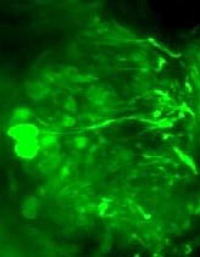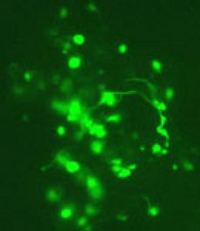METHOD FOR THE REGENERATION OF NEURITES FROM ADULT NEURONS OF THE SPIRAL GANGLION
|
Description |

Spiral ganglion explants from aged mice.
Complutense University of Madrid (Spain) offers a method to regenerate neurites from explants of the spiral ganglion. This neuronal regeneration is independent of the age of the animal, since the growth of neurites is observed from newborn, young, adult and aged spiral ganglia.
In order to apply this method from hearing loss patient is required developing a new biopharmacological product, and a new hearing bioprosthesis. An important characteristic of this new product is required that allows to the liberation of the growth factors for growth of neurites from spiral ganglion neurons.
This method is fitted within the field of the biomedicine, more specifically, within the regenerative medicine of the auditory system.
The great advantage of this method that proposed the regeneration of neurites in vivo is that the hearing loos patient takes in charge to continue their own neurons with transmission of the sound in all cochlear frequencies and intensities. In contrast to the performance of the present auditory prothesis, that this patients hearing with a limited representation of cochlear frequencies and intensities. It is for this reason that the hearing loos patients must adapt to “a new form to hear” after surgery.
In order to apply this method in human patients is necessary the collaboration with two different types of enterprise:
- The collaboration of biotechnology, biopharmacology and/or biomedicine enterprises will allow to prepare and market the final product (compendium of different products used in the method) that must be administered to the human.
- The collaboration with companies interested in the production of a performed nanotechnology prosthesis adapted to allow the diffusion of the product within the cochlea.
|
How does it work |
In developed societies, the number of hearing-loss patients is increasing dramatically by the environment and type of life. Likewise, the population of elderly people with presbycusis is the second cause of pathology in the elderly, after presbyopia.
The method that has been developed allows the standardization and simplification of in vitro conditions for neuronal regeneration in the auditory system. To achieve that these culture conditions are reproducible in vivo, it has been considered:
- The substrate on which the explant must adhere,
- Conditioned culture medium (growth factors and specific components).
The adhesion of neurons to the substrate is a fundamental feature for the regeneration of neurites, especially in spiral ganglion neurons of mature and aged animals. The substrate consists of fibronectin, collagen, laminin and poly-L-lysine components present in the neuropile of the spiral ganglion under in vivo conditions. The polymerization of these substrates is carried out in two processes:
1. - The cocktail of substrates formed by fibronectin, collagen, and laminin polymerize in cold.
2. - Polymerization of the poly-L-lysine is carried out at room temperature or 37 ° C.
The culture conditioned medium is the second fundamental characteristic to carry out the regeneration of in vitro neurites. The nutritional components and trophic factors used at specific concentrations allow permeability and diffusion through the plasma membrane without being toxic to neurons. In addition to the optimal reuptake and incorporation of the nutrients that will provide the nutritional and energetic requirements, the incorporation into the neuron of neurotrophic factors allows the regeneration of neurites of adult and aged neurons.
The resulting product can be applied to patients with different types of sensorineural hearing loss. This product does not cause any cochlear injury. The regeneration of neurites of the spiral ganglion allows to recover the function of a structure of biological form (neurons) in a system as complex as the hearing. The viability of neurons allows the patient to have accurate hearing for all audible intensities and frequencies in the human ear.
|
Advantages |

Neurons and neurite regenerated in vitro labeled with 200K anti-neurofilaments.
The developed method displays like great newness that is the first time that regenerates neurites from explants of adult neurons of the spiral ganglion, in vitro conditions. Moreover, in the development of the method the substrates and culture medium have been considered with the purpose of obtaining results without putting under the neurons nonviable conditions in vivo. Therefore, improving the problems related to hearing loos and different neurosensory deafnesses including presbiacusia, pathology more and more frequent in of otolaryngology clinics of developed societies.
The immediate advantages of this method that can contribute to the company are:
- To generate a new product (biotechnology/biomedicine) that allows to use the method.
- The use of this new product does not generate any injury organic to be applied. The regeneration of neurites of the spiral ganglion allows recovering the function of biological structure (neurons) in a complex sensory system as it is hearing. The viability of the neurons allows to the patient precise hearing for all the intensities and audio frequencies to the human ear.
- The new product can have a great repercussion in the market if its cost is inferior to the present prices of auditory prosthesis and cochlear implants.
- The new product can be applied to patients with different types from sensory neuronal deafness. One is due to consider, that in the developed societies the number of hearing loos patients this vertiginously being increased by the type of life and environmental conditions. The presbycusis is the second cause of pathology in the old people after the presbytia.
- The auditory prothesis and cochlear implants do not replace completely the audition, and this is the usual reason and difficulty of the hearing loos patient that must be adapt “to the new form to hear”.
- The surgery of cochlear implant request to destroy the cochlea, without any possibility of replacing it by another auditory system in case of deterioration or non-viability. Also, the cochlear implant is not advisable to be implanted in certain auditory pathologies, and nor to any age. There are different studies that put in doubt their effectiveness in presbycusis patients.
|
Where has it been developed |
This work has been developed in the Department of Ophthalmology and Otolaryngology of the Faculty of Medicine of the UCM.
|
And also |
The enterprises to which it can interest are:
- Enterprises related to systems of improvement of hearing that they are investigating at the present time in new systems of auditory prosthesis to replace the deficiencies in hipoacusics patients.
- Enterprises dedicated to the biopharmaceutical or biotechnology.
- Enterprises producing of micro or nanotechnology to design a new product that allows like introducing and spreading the cocktail of factors of growth in the internal ear.
The company must be involved in the research grant by facilitating the qualified incorporation of technical staff to carry out the project of regenerating neurites in humans.
|
Contact |
|
© Office for the Transfer of Research Results – UCM |
|
PDF Downloads |
|
Classification |
|
Responsible Researcher |
María Visitación Bartolomé Pascual: mvbartol@med.ucm.es
Department: Ophthalmology and Otolaryngology
Faculty: Medicine


